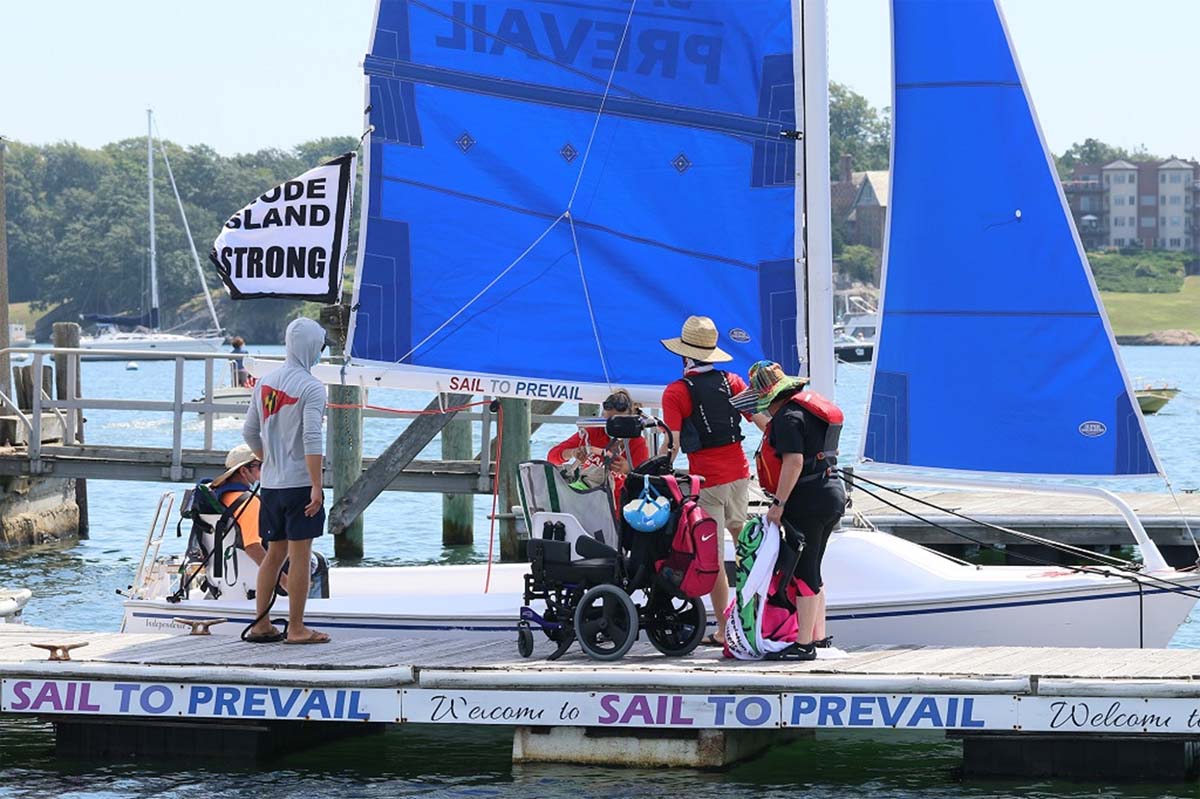
It’s All About Accessibility
Published on May 4, 2023How many times have you sprained an ankle, broken a bone, or otherwise had a temporary mobility issue? I know I have, on more than one occasion, and thankfully they were all relatively minor and short-lived injuries. I was fortunate that the injuries were not more severe or permanent, even though at the time of the injuries I might not have been thinking that. But there is a growing segment of the population, particularly as more and more baby boomers reach retirement, that unfortunately have mobility and other issues that are longer-term or permanent.
At a point many years ago, when I was interacting with the U.S. Access Board – the organization that develops ADA guidance/requirements in the United States – and providing industry input on the draft rules for recreational boating and fishing facilities, I learned the term TAP, which stands for Temporarily Accessible Person. A simple but very potent concept, as we are all just one incident away from being a person with a disability, whether for the short or long term.
Designing for Mobility Issues
In fact, it was not long ago that I twisted my ankle and had to wear a boot cast. I have been designing facilities for decades to be compatible with those with mobility issues. However, when wearing the boot, I became that much more acutely aware of what mobility issues are and how designs can be tweaked to be even more accessible for those with mobility issues. About the same time, the wife of a coworker suffered a bad leg break and had to be in a wheelchair for three months. He gained plenty of first-hand experience in how quickly a wheelchair’s front wheels can come to a dead stop with something as small as a ½-inch unbeveled bump. Yes, a simple little bump can be a major hurdle for one with mobility issues, and a raised door saddle between rooms can be a major obstacle to overcome.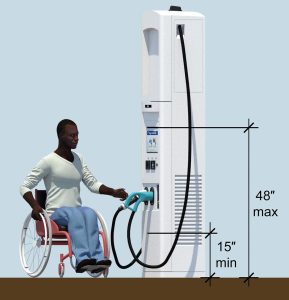
The truth is that it usually does not cost more, or much more, to make designs accessible. And accessibility is not only good for people with mobility issues – making paths of travel and facilities easier to use is welcomed by all. Carrying packages, groceries, or other items to or from one’s boat is always a chore, so having a lack of trip hazards, steps, and obstacles is overwhelmingly appreciated. Even more so if you happen to be pushing your spouse in a wheelchair – or your kids in a stroller.
While the Americans with Disabilities Act was a frontrunner, most countries these days have their own version of accessibility rules. For the international marine industry, PIANC, The World Association for Waterborne Transport Infrastructure, adopted a set of accessibility guidelines, which I helped author, that parallels the broad features of the U.S. rules.
The specific U.S. ADA rules for the recreational marine industry are largely written as exceptions to the main rules, and then there are exceptions to the exceptions. It can be confusing and sometimes feels like overkill in some areas. However, in most cases, it isn’t expensive, if you plan for it in both your maintenance and capital budgeting process.
With respect to existing facilities and what triggers ADA compliance requirements, there are some basic guidelines to follow. “Fix what you touch” – which means that if you must replace something and it can be made compliant on a reasonable basis, then you should do it. If the doorknob to the men’s restroom breaks and needs to be replaced, then it should be replaced with compliant hardware, even if the rest of the door and restroom are not yet compliant.
A key factor to keep in mind on this rule is that one should not put off maintenance, repair or replacement work in situations where you truly cannot afford it or it’s technically infeasible to carry out the accessibility fix to what needs touching. And if your facility already complies with its overall accessibility requirements and there is work needed in some part of the facility that is not required to be accessible, then again there would be no requirement to apply the accessibility fix. Although in many situations it may well just make sense to incorporate at least some of the accessibility guidelines, like eliminating trip hazards, it will make the facility safer and easier to use for everyone.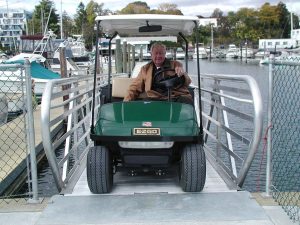
“Cheap & Easy” – which means that you are obliged to actively remove barriers where readily achievable (easily accomplished without much difficulty or expense). Are there simple improvements that you could undertake to improve accessibility, such as replacing the doorknob even though the existing knob is not broken, or adding a piece of diamond plate to eliminate the existing bump at the entrance to your gangway, or to cover the gap between your existing floats?
“20% Rule” – which means that any time an improvement is made to a primary function area then up to an additional 20 percent of the cost of the project must be spent on improving the accessible path (unless the entire accessible path is already or can be made fully compliant with the Accessibility Guidelines for less than 20 percent). Improvements to the accessible path can include any feature that is not the primary function of the facility. For marinas, slips usually are the primary function. Therefore, such things as gangways, paths, parking spaces, restrooms, water fountains, and even vending machines on the accessible path can qualify for the 20 percent of improving the accessible path.
So, if a marina facility is going to undertake a $100,000 capital improvement by adding new fingers and removing and replacing existing fingers, then, if the facility is not already ADA compliant, up to an additional 20 percent, or $20,000, has to be applied to barrier-free compliance, which could be installing a compliant gangway, removing stairs or trip hazards, or even upgrading the restrooms. In large part, the approach to compliance expenditure is dependent upon how one defines their “primary function.”
Defining one’s primary function and designating the areas of compliance can be very important to maximizing flexibility in how compliance is achieved and maximizing the expenditure for the improvements.
It does not take much to understand the broad concepts of accessibility. Most are based on practical concepts. It gets murkier when you get into the specifics. The specifics are laid out in the various guidelines, rules, and regulations. As it turns out, among the murkiest specifics in the U.S. rules are what constitutes a “reasonable basis,” “technically infeasible,” and “readily achievable,” as there are no quantifiable thresholds laid out, which leaves it to those at the Access Board to advise, those at the U.S. Justice Department to make judgments as the onsite enforcers, and to the courts for the finality of deciding – and for facility owners to decide how much risk they are willing to take on.
Following the Guidelines
The U.S. Access Board has set forth written guideline documents, together with diagrams and pictures, all of which can be found on their website at https://www.access-board.gov/. The Access Board also has a helpline that can be reached at 1-202-272-0080. A note of caution – as attitudes and perspectives have changed over the years on almost everything in life, so has some of the advice forthcoming from the Access Board’s helpline as well as from the Justice Department’s representatives on specific investigations – and there can be the difference of interpretation within and between the agencies making things perfectly murky. This is due to changing perspectives and turnover in personnel and interpretations. Whenever you are undertaking work that is more dependent on language that is less clear as to its meaning, it makes sense to check in with the Access Board as to its current interpretation – as well as to keep abreast of new rules or guidance and published decisions.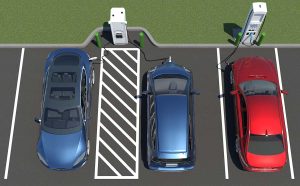
Speaking of new guidance, if a marina is contemplating the installation of electric vehicle charging stations in the parking lot, there are now accessibility guidelines for both the actual charging stations and the parking spaces that serve them. No news so far on electric boat charging parking spaces. That said, if you are installing a boat charging station, it makes sense to make it as accessible as possible similar to the rules for other utilities.
In fact, accessibility applies to so many things we do not always think too much about. Power pedestals come right to mind. If a marina has power pedestals, the accessible slips need to have accessible power pedestals. And if a marina is installing new pedestals elsewhere; it would make sense to install accessible units if this can be reasonably accomplished.
Security gates are another feature not always given enough thought. If there is a gate on the path to accessible slips, it also needs to be accessible, including meeting the clear space requirements on both sides of the gate, ease of opening and closing, and door hardware. If there is a keypad for security, it would need to meet keypad requirements. As with the power pedestals, it would make sense to install at least the compliant door hardware on all gates so as to make them easier to use.
It also makes sense to undertake an assessment of the entire facility. If you are not sure how to do it, put a boot cast on your foot or get in a wheelchair and roam the facility (or push your spouse in a wheelchair around the facility). You might be surprised at what you find. Or you can ask your insurance carrier to undertake a review, or a knowledgeable consultant.
Create an Accessibility Plan
Next is to create an accessibility plan for the entire facility. Identify the areas that are not in compliance and what is envisioned to bring them into compliance. A broad timetable is helpful but not necessarily required. I recommend that it be combined with operational and capital budgeting, which helps to set targets. If renovations, reconfigurations or additions are contemplated, they can easily incorporate correcting at least some of the accessibility issues as part of the project.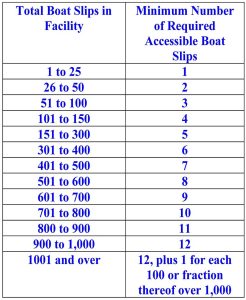
Remember that the gangway exceptions from the regular ADA ramp rules are for gangways to floating docks only. Ramps on your upland and ramps to a fixed pier all need to meet the regular ramp guidelines. As a refresher, the biggest of those gangway exceptions are that you do not need to have level landings every 30 feet, and you can exceed the ramp rule’s one foot vertical for every 12 feet horizontal maximum slope once you reach an 80-foot long gangway (for facilities with fewer than 25 slips, a 30-foot gangway is the maximum required length).
For facilities with multiple access points, the ADA rules allow grouping of access to ADA slips to one area with one access point, providing the ADA slips can accommodate the various sizes and types of boats able to be berthed at the total facility and offer comparable amenities. That means that one would only need one compliant entrance/gangway, which can make things simpler (and less expensive) at many facilities.
The actual boarding areas for boats, whether on fixed or floating mains or fingers, must be at least 60 inches by 60 inches clear. If boarding is from fingers, the fingers are required to be a minimum of five feet wide.
Also remember that for your official minimum number of accessible slips, you need to have an established policy for how those are made available, typically including a cutoff date/time after which they can be made available to those without a qualifying disability.
Keep in mind that there can be a fairly wide range of achieving accessibility, but facilities that make a sincere effort will always be regarded more highly than those who willfully ignore it.
The more accessible a facility is, the more inviting the facility is, not only for those with mobility issues, but to all customers, and this can easily lead to raising rates and a better bottom line. It can also help prevent nuisance lawsuits that almost always cost more than doing the right thing.
There are many organizations that marina owners and operators can utilize to learn more. Shake-A-Leg and Sail to Prevail in the United States go above and beyond to make it possible for people with disabilities to get out on the water. Sailability also has many chapters in locations ranging from Australia to the United Kingdom.
Dan Natchez, CMP, is president of DANIEL S. NATCHEZ and ASSOCIATES Inc., an international environmental waterfront design consulting company specializing in the design of marinas and marina resorts throughout the world. He can be contacted by phone at 914/698-5678, by WhatsApp at 914/381-1234, by email at dan.n@dsnainc.com or online at www.dsnainc.com.
| Categories | |
| Tags |




